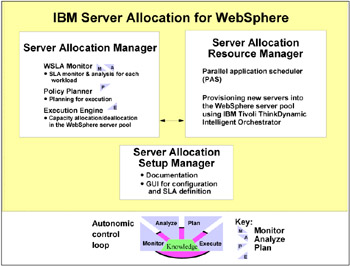IBM Server Allocation for WebSphere Application Server
|
| < Day Day Up > |
|
The HVWS team and IBM Research are developing on demand technology using constructs of the autonomic control loop and open Web services standards. IBM Server Allocation for WebSphere Application Server enables WebSphere customers to balance workloads and allocate resources on demand. IBM intends to enhance it as the emerging Open Grid Standard Architecture (OGSA) protocols mature, and make it an integrated component of a future version of the WebSphere Application Server.
IBM Server Allocation allows the customer to run multiple transactional applications and one parallel application in the same grid infrastructure. As the traffic of a higher priority workload increases to such a level that the service level agreement (SLA) objective cannot be met, the system drains the lower priority workloads to other servers in the local or remote grid, to make additional servers available for high priority transactions. When all the servers in the WebSphere server pool are at a high use level serving high priority applications, IBM Server Allocation for WebSphere integrates with IBM Tivoli Intelligent ThinkDynamic Orchestrator to provision additional servers from the data center server pool. As the traffic of the higher priority workloads decreases, the system schedules the lower priority workloads on to the servers where they were previously running.
The primary components of the offering, as shown in Figure 1-1, are defined to support the goals of the autonomic control loop.

Figure 1-1: Components of the IBM Server Allocation for WebSphere
IBM Server Allocation has three major components:
-
The server allocation manager component is the most sophisticated of the three. It provides the autonomic control loop functions. It contains subcomponents that monitor workloads, analyze data to determine if the workload will continue to meet its service level agreement, and if needed, plans whether resources need to be reallocated, and invokes the server allocation resource manager to reallocate as needed.
-
The server allocation resource manager allocates resources as needed to meet service level objectives. Its major subcomponent, the parallel application scheduler (PAS), decomposes processing of parallel applications into tasks that can be executed on the available CPUs in parallel, distributes these tasks across the CPUs, and gathers and combines the results. When all the servers in the WebSphere server pool are at capacity, the server allocation resource manager calls IBM Tivoli Intelligent ThinkDynamic Orchestrator to provision a server from the data center server pool into the WebSphere server pool.
-
The server allocation setup manager facilitates setting service level agreements, and controlling the installation and operation of the Server Allocation components. It is fully integrated with the WebSphere Application Server administration framework.
Server Allocation includes WebSphere Studio Application Developer plug-ins to help in the development of new parallel applications or allow you to modify existing parallel programs that are written in C, Fortran, or other programming languages. Customers can also easily develop Java applications with a new API, so that the application can take advantage of the servers in the WebSphere environment.
|
| < Day Day Up > |
|
EAN: N/A
Pages: 117